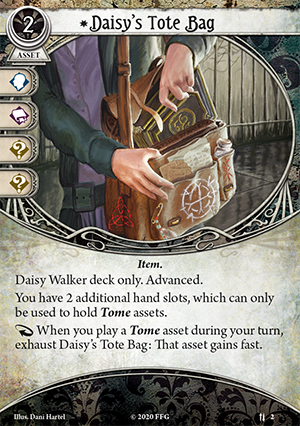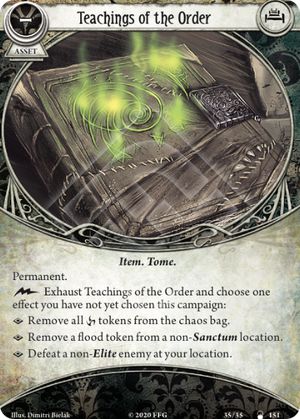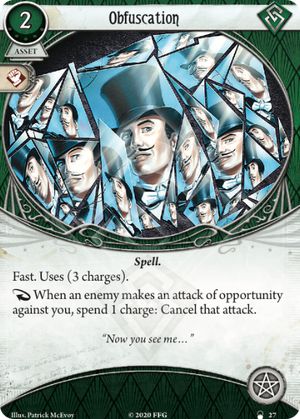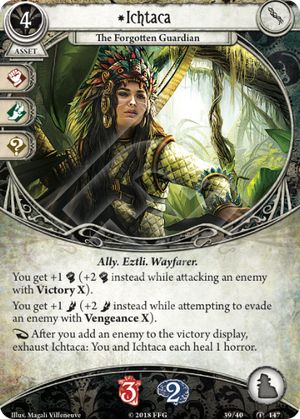
Edit: I completely forgot the "unrevealed" condition. That really ruined the intent I wrote here for this card. It just becomes incredibly niche and I don't think it can get out of Shortcut's shadow.

Edit: I completely forgot the "unrevealed" condition. That really ruined the intent I wrote here for this card. It just becomes incredibly niche and I don't think it can get out of Shortcut's shadow.

Have you ever gone to the library and left with fewer books than you thought?
Or do you always seem to leave with more than you can carry, promising yourself that you’re definitely going to knuckle down and take on a few extra novels?
(If you’re spending your spare time reading card reviews for a very reading-heavy card game, the question is the answer.)
Daisy is super good at big hand strategies, owing mostly to the old book of lore. But with scroll of secrets now being a fast action, you’ll want it in play as much as possible. Having both means you won’t have a slot open for an encyclopedia or the Necronomicon.
This bag gets even better as you level up, because a library doesn’t put a card from your hand slot into your… Hand of cards. You can instantly replay it. Add calling in favors to put that docent into your hand, and you’re getting three uses out of the same card, and you save actions.
Fast actions mean you can put super useful books into play while enemies threaten to chew on your face. Like a Necronomicon translation that does direct damage.
It’s worth playing “read or die” though, because this card, while good, is not as positive as the advanced weakness is negative.
And remember, those books are gonna be due back in a month.

This one is hard to get, the second hardest bonus objective in a difficult scenario.
I was playing is Daisy and unknowingly had another character complete the objective, which is a downer!
Each of these abilities is good. It could save your life in scenarios not too hard to imagine. But for Daisy, it’s a permanent, slotless boost to Whit Greene, and an extra card every time you get your elder sign for the rest of the campaign. If you are parallel Daisy, it’s a permanent +1 willpower. That means you can get up to a six with your special tote bag out, more if you somehow get Dr. Elli to carry a tome relic for you.

This is an auto-include for Trish Scarborough. Use the enemy at your location to gain a 2nd clue, with this card picking up the AOO cost. This is particularly good for high evade enemies, where you will use Trish’s ability to evade/exhaust your enemy, then investigate to pick up remaining clue/s. The cost is low, has no action cost, and the asset slot is wide open for Rogue/Seekers. Yeah, it has Dexter on it, but Dexter can already play assets without action costs, and he wants more offensive/clue-getting spells in his slots.

She costs 4! 4!!! :D Pretty expensive , obviously. Ok lets be honest she is a great tank and great stat booster especially if you are Silas who likes to control board and kill stuff when he find his weapons. In fact he is great with this card's campaign since you dont want to kill enemies with vengence if possible. He can use her to greatest extend outside of her campaign she will allways give you +1 agilty since vengence is a unique mechanic but you will get +2 str anytime
Now you may be thinking "what if there isnt a victory point card in scernio" It is rare but that happens but good thing is when that happens most of the time enemies are easy, mostly cultists or some lowly ghouls. So she is helping you most at times that you need most But her abilty is not just her horror soak its just minor boost. Her stat boost is amazing as long as you use both agilty and str but If you dont... I guess it depends then. She becomes very "meh" if you dont use agilty too and you should never pick this if you dont use STR because you will miss most of her boost then(she cant heal horror without killing and vengence is only exists at 1 campaign) I think any rogues that can use weapons is very good with her still. She is still very expensive so watch your economy.
In short:She is an ally that says "I will help you to control board , either to kill or exhaust
Edit:After thinking for a while she is also an interesting choice for characters that cant access to str boost like seekers with strange solution. 1 of biggest problem with strange solution is 6 str without any skill boost tend to miss a lot so it might be a problem but Ichtaca is a good solution to that . Someting you might consider.